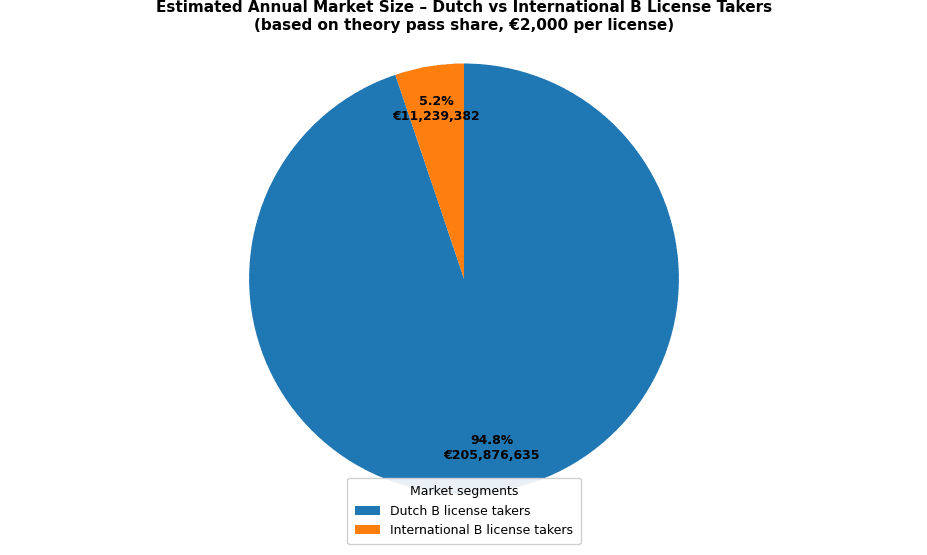License Pass Report · Category B
How Big Is the International B License Market in the Netherlands?
Time horizon: 2024–2025
Published: November 18, 2025

Average pass rate
48.7%
Analyst note
Using passed theory exams as a proxy for nationality, about 5.2% of successful B candidates follow the English exam route. Applying this share to practical passes and an average €2,000 license cost suggests roughly €11.2 million per year is spent by internationals on getting a Dutch B license, out of an estimated €217 million total market.
This report gives a rough but intuitive estimate of how many internationals get their Dutch B driving license each year, and how much money they collectively spend on lessons and exams – compared with Dutch candidates.
The pie chart visualises the estimated annual market size for B licenses: most spending comes from Dutch learners, but internationals still represent a noticeable slice of the market.
1. Step 1 – Using theory passes to estimate the international share
We start from the theory exams for license B:
- Passed Dutch theory (BTH): 206,584
- Passed English theory (BTH-E): 11,278
Here we make a simple but reasonable assumption:
BTH-E ≈ internationals,
BTH ≈ Dutch candidates
To avoid double-counting people who fail several times, we look only at passed exams, not all attempts.
We then compute the share of English passes in all successful theory exams:
International share
= BTH-E / (BTH + BTH-E)
= 11,278 / (206,584 + 11,278)
≈ 0.0518 → 5.18%
So, roughly 5.2% of all people who eventually pass the B theory test do so in English. This is our proxy for the share of international candidates who successfully complete the theory stage.
2. Step 2 – Applying that share to practical exam passes
Next, we move to the practical B exam:
- Total passed practical B exams: 108,558
We now assume that the same 5.18% share holds among successful practical candidates. In other words, the proportion of internationals among people who finish the full B license is similar to the proportion we see in passed theory.
Estimated international passes
= 108,558 × 5.18%
≈ 5,620
Estimated Dutch passes
= 108,558 − 5,620
≈ 102,938
Answering the big question:
How many internationals get their Dutch B license each year?
Based on this pass-based proxy, around 5,600 internationals obtain a B license annually, out of roughly 109,000 successful candidates in total.
3. Step 3 – Converting passes into market size (€)
To translate this into money spent on getting a license, we use a simple, transparent assumption:
Average total cost per B license (lessons + exams) = €2,000
for both Dutch and international candidates.
Multiplying the estimated number of successful candidates by €2,000 gives:
-
Dutch students:
102,938 × €2,000 ≈ €205,876,618 -
International students:
5,620 × €2,000 ≈ €11,239,382 -
Combined B-license market (Dutch + internationals):
≈ €217,116,000 per year
This is what the pie chart shows: around €206 million in spending from Dutch candidates and about €11 million from international candidates, or roughly a 95% / 5% split in monetary terms.
4. What does this mean in practice?
-
How many internationals get their driver’s license in the Netherlands?
Our estimate suggests around 5,600 internationals successfully complete the B license each year. -
How much money do internationals spend on driving lessons and exams?
Using the €2,000-per-license assumption, the international segment represents about €11.2 million in annual spending. -
How big is the overall B-license market?
For Dutch and international candidates combined, the estimated yearly B license market is around €217 million.
5. Why this method and what are the limitations?
This approach is deliberately simple and transparent:
- Use passed theory in Dutch vs English to estimate the share of successful Dutch vs international candidates (avoiding double-counting repeat fails).
- Apply that share to passed practical exams to approximate how many full-license holders are internationals.
- Multiply by a single average cost (€2,000) per license to get a market-size estimate.
It does not account for:
- Different average package prices for Dutch vs internationals
- Extra retakes and additional lessons for some candidates
- Regional price differences between driving schools
So the numbers should be seen as a clean, order-of-magnitude estimate, not a precise financial statement. Still, the conclusion is clear:
Internationals are a relatively small but financially meaningful segment of the Dutch driving license market – about 5% of successful B candidates and roughly €11 million in spending per year.
Source: https://www.cbr.nl/nl/service/nl/artikel/1-oktober-2024-tm-30-september-2025